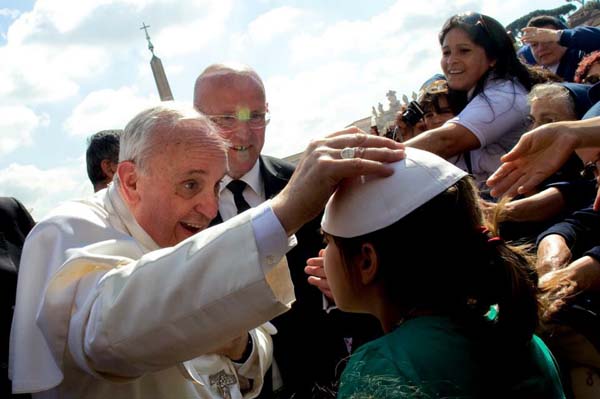 Two weeks ago when Pope Francis arrived in Ecuador and emerged from the plane, a breeze whipped off his white zucchetto (skull-cap) and swirled his robes. He smiled and laughed and took it in stride. The same thing happened about 6 months earlier in January, 2015 when he disembarked his plane in the Philippines. When such things happen, there are always extra caps nearby. In December 2013, as the Pope held a youngster in his arms while touring the Vatican pediatric medical center, the curious child pulled off Francis’s skullcap, but the Pope smiled and was able to retrieve his headwear and return it to his head. At these three occasions the Pope’s head was temporarily exposed, a site rarely seen in public. Since the 1500s, Popes have worn white skullcaps as part of their formal dress, and they always celebrates mass and performs most other official duties while wearing one. Cardinals wear scarlet or light red colored zucchetto and bishops wear ones colored amaranth (more of a red-rose hue). All priests and deacons may wear a black zucchetto, though it has fallen out of use, except in some monasteries. The spiritual leaders of other faiths, including rabbis, imams and mumbakis traditionally wear similar caps. The zucchetto’s name is derived from its resemblance to half a pumpkin (zucca). In the Catholic tradition, the zucchetto is most commonly made of silk or polyester fabric. The design utilizes eight triangular panels that are joined to form a hemispherical cap. Jutting from the top is the “stem” made of a twisted loop of silk cord for easier handling. Most modern zucchetto designs include a cloth lining. The common tradition is for the cleric to obtain the zucchetto either from an ecclesiastical tailor or a retail church supply. There is also a tradition of friends buying the newly appointed bishop his first zucchetto. The original use of the zucchetto was purely practical. Clerics had a ring of hair removed off the top of their head when they embraced celibacy. The skull-cap was meant to cover the bald spot and retain body heat, an absolute necessity in the unheated churches and monasteries of the past. From this practical use the cap acquired the role of identifying ecclesiastical rank by color. Last September a host of an Italian satirical TV show went up to Pope Francis as he was passing through the crowd during his regular audience a St. Peter’s Square. The host asked for the Pope’s cap in exchange for a new one bought off the shelf from a retail store. The Pope carefully compared the cap to his own then agreed to the swap with a laugh after finding it was the same size. The TV show then put up the cap for auction on eBay to raise funds for an Italian charity which donates money to fight child mortality in the Democratic Republic of Congo. The cap raised more than $250,000 for the charity.
Two weeks ago when Pope Francis arrived in Ecuador and emerged from the plane, a breeze whipped off his white zucchetto (skull-cap) and swirled his robes. He smiled and laughed and took it in stride. The same thing happened about 6 months earlier in January, 2015 when he disembarked his plane in the Philippines. When such things happen, there are always extra caps nearby. In December 2013, as the Pope held a youngster in his arms while touring the Vatican pediatric medical center, the curious child pulled off Francis’s skullcap, but the Pope smiled and was able to retrieve his headwear and return it to his head. At these three occasions the Pope’s head was temporarily exposed, a site rarely seen in public. Since the 1500s, Popes have worn white skullcaps as part of their formal dress, and they always celebrates mass and performs most other official duties while wearing one. Cardinals wear scarlet or light red colored zucchetto and bishops wear ones colored amaranth (more of a red-rose hue). All priests and deacons may wear a black zucchetto, though it has fallen out of use, except in some monasteries. The spiritual leaders of other faiths, including rabbis, imams and mumbakis traditionally wear similar caps. The zucchetto’s name is derived from its resemblance to half a pumpkin (zucca). In the Catholic tradition, the zucchetto is most commonly made of silk or polyester fabric. The design utilizes eight triangular panels that are joined to form a hemispherical cap. Jutting from the top is the “stem” made of a twisted loop of silk cord for easier handling. Most modern zucchetto designs include a cloth lining. The common tradition is for the cleric to obtain the zucchetto either from an ecclesiastical tailor or a retail church supply. There is also a tradition of friends buying the newly appointed bishop his first zucchetto. The original use of the zucchetto was purely practical. Clerics had a ring of hair removed off the top of their head when they embraced celibacy. The skull-cap was meant to cover the bald spot and retain body heat, an absolute necessity in the unheated churches and monasteries of the past. From this practical use the cap acquired the role of identifying ecclesiastical rank by color. Last September a host of an Italian satirical TV show went up to Pope Francis as he was passing through the crowd during his regular audience a St. Peter’s Square. The host asked for the Pope’s cap in exchange for a new one bought off the shelf from a retail store. The Pope carefully compared the cap to his own then agreed to the swap with a laugh after finding it was the same size. The TV show then put up the cap for auction on eBay to raise funds for an Italian charity which donates money to fight child mortality in the Democratic Republic of Congo. The cap raised more than $250,000 for the charity.
Sources: Reuters.com, GMA news, Dailymail.co.uk, EWTN.com, Wikipedia.org, The Washington Post, RT.com
